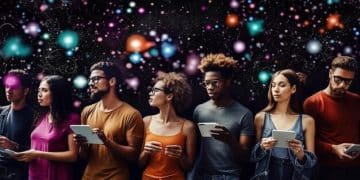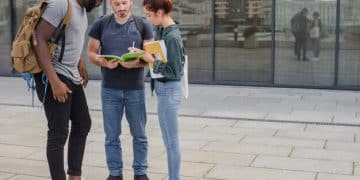Media Representation & Social Stereotypes: An In-Depth Look

Media representation, spanning news to entertainment, plays a pivotal role in shaping public perception and can inadvertently entrench social stereotypes by consistently portraying certain groups narrowly, impacting societal norms and individual identities significantly.
In an increasingly interconnected world, the media serves as a powerful mirror, reflecting and, at times, distorting the complex tapestry of human society. The topic of Examining the Role of Media Representation in Perpetuating Social Stereotypes is more relevant than ever. From blockbuster films to daily news reports, the images and narratives we consume profoundly influence our understanding of different social groups, often solidifying preconceived notions rather than dismantling them.
The Pervasive Influence of Media Narratives
Media, in its myriad forms, from traditional newspapers and television to digital platforms and social media, acts as a primary conduit for information and cultural exchange. Its pervasive presence in our daily lives means that the representations it offers are not merely reflections but active shapers of our collective consciousness. These narratives, often oversimplified, can inadvertently reinforce societal biases and stereotypes, making the complex seem uniform and the diverse appear monochromatic.
The impact of media extends beyond mere entertainment or information dissemination. It cultivates perceptions, sets agendas, and, crucially, normalizes certain behaviors and attributes associated with specific groups. When these portrayals consistently lean into stereotypical representations, they can significantly influence how individuals perceive themselves and others, fostering prejudice and discrimination.
Historical Context of Media Stereotypes
Historically, media’s role in perpetuating stereotypes is well-documented. Early cinematic portrayals, for instance, often depicted racial and ethnic minorities through highly caricatured lenses, contributing to widespread misconceptions and dehumanizing narratives. These early representations laid foundations that continue to reverberate, often subtly, in contemporary media.
- Racial and Ethnic Caricatures: From minstrel shows to early Hollywood, depictions often reduced complex cultures to one-dimensional, often negative, traits.
- Gender Roles Reinforcement: Traditional media frequently cast women into narrow domestic or subservient roles, limiting broader societal aspirations.
- Socioeconomic Stereotypes: Negative portrayals of poverty or wealth often ignored systemic issues, blaming individuals rather than examining structural inequalities.
Understanding this historical lineage is crucial for dissecting how modern media continues to grapple with and, at times, inadvertently perpetuate these harmful patterns. The echoes of past media biases are present in the subtle cues and character archetypes of today.
The challenge lies in recognizing these deep-seated patterns and actively working towards more nuanced and equitable representations. Journalists and content creators bear a significant responsibility in ensuring their narratives are inclusive and reflect the true diversity of human experience, rather than relying on outdated or harmful tropes. This proactive approach is essential for breaking the cycle of embedded stereotypes.
Deconstructing Stereotypes: How Media Works its Magic (or Mischief)
To truly grasp how media perpetuates social stereotypes, it’s essential to deconstruct the mechanisms at play. This isn’t always about overt, malicious intent; often, it’s a byproduct of narrative shortcuts, unconscious biases, or the pressure to appeal to a broad audience by relying on familiar tropes. Yet, the outcome remains problematic, solidifying harmful perceptions.
One primary mechanism is the concept of “schema theory,” where the brain processes information by organizing it into mental frameworks. When media consistently presents a particular group in a specific way, it reinforces or creates a schema for that group. For example, if news consistently associates a certain demographic with crime, readers begin to form a cognitive link between the two, even if individual facts don’t support a causal relationship.
The Power of Repetition and Absence
Repetition is a powerful tool in media, not just for advertising, but also for embedding cultural narratives. When certain portrayals are repeated ad nauseam, they gradually shift from being mere fictional representations to seeming like factual reflections of reality. The sheer volume of similar portrayals can make a caricature feel like a common truth.
- Reinforcement through Frequency: The more often a stereotype appears, the more it seems “normal” or “true.”
- The Impact of Omission: The absence of diverse or counter-stereotypical representations can be as damaging as overt negative ones, implying that certain groups simply don’t exist in various roles or contexts.
- Narrow Casting: Limiting characters from specific groups to only a handful of predetermined roles (e.g., the “magical negro,” the “sassy black woman,” the “terrorist Arab”) restricts how audiences perceive their full humanity.
Consider the portrayal of mental illness in media. Historically, characters with mental health conditions were often depicted as violent, unpredictable, or comedic foils. This consistent, narrow framing contributed to significant societal stigma, making it harder for individuals to seek help and for society to empathize. Even now, while improvements have been made, the sensationalization of mental health issues in some news narratives continues to be a concern.
Furthermore, the media’s focus on sensationalism often prioritizes shock value over accuracy, leading to disproportionate coverage that can create skewed perceptions. A single crime committed by an individual from a minority group might receive extensive coverage, feeding into broader negative stereotypes about that group, while similar crimes committed by others may go largely unnoticed.
Symbolic Annihilation: When Groups are Invisible
Beyond negative portrayals, “symbolic annihilation” refers to the media’s tendency to either condemn, trivialize, or completely omit particular groups, rendering them invisible or insignificant in the cultural landscape. This absence sends a message that these groups do not matter or are not relevant to mainstream society. Historically, LGBTQ+ individuals, people with disabilities, and indigenous communities have often been subjected to such invisibility, leading to a lack of understanding and empathy from the dominant culture.
- Exclusion: Simply not featuring certain groups in narratives, or only doing so in tokenistic ways.
- Trivialization: Representing groups in ways that diminish their importance or the seriousness of their experiences.
- Condemnation: Portraying groups as outright deviant, dangerous, or immoral.
The subtle ways in which media constructs reality mean that even well-intentioned shows or news reports can fall into the trap of stereotype perpetuation. A critical media literacy is therefore paramount for audiences to discern these patterns and challenge the narratives presented to them.
The Psychological Impact on Audiences and Individuals
The consistent bombardment of stereotypical media representations has profound psychological consequences, influencing both the individuals being stereotyped and the broader audience consuming these images. For those who see their own groups misrepresented, the effects can range from diminished self-esteem to internalizing negative stereotypes. For the audience, repeated exposure can lead to the subconscious acceptance of biases and an inability to perceive individuals beyond their group identity.
One significant psychological impact is the phenomenon of “stereotype threat.” This occurs when individuals are aware of negative stereotypes about their social group, leading to anxiety and poorer performance in situations where the stereotype might be relevant. For instance, if media consistently portrays a certain gender as unskilled in STEM fields, women pursuing those careers might experience stereotype threat, affecting their confidence and performance.
Internalization and Self-Perception
Individuals from stereotyped groups can internalize the negative representations they repeatedly encounter. This internalization can lead to a distorted self-image, feelings of inadequacy, and a reduced sense of possibility. Children, in particular, are highly susceptible to these messages, as their identities are still forming. If they rarely see positive, diverse representations of people who look like them, it can limit their aspirations and perceptions of what they can achieve in life.
- Lowered Self-Esteem: Constant negative portrayals can erode an individual’s sense of worth and belonging.
- Limited Aspirations: Lack of diverse role models can make individuals believe certain paths are not open to them.
- Increased Stress and Anxiety: Dealing with societal biases fueled by media can lead to significant psychological distress.
Additionally, the media’s emphasis on physical appearance, particularly for women, can foster body image issues and eating disorders. When a narrow ideal of beauty is constantly reinforced, it creates unrealistic expectations and pressures that can be detrimental to mental and physical health across different demographics, contributing to the perpetuation of unrealistic beauty standards.
For the wider audience, the psychological impact manifests as unconscious bias. Even if individuals consciously reject stereotypes, consistent media exposure can create subtle, automatic associations in their minds. This unconscious bias can influence decision-making in various contexts, from hiring practices to social interactions, and contribute to systemic discrimination without explicit intent.
Fueling Prejudice and Discrimination
At a societal level, media stereotypes can exacerbate existing prejudices and foster new ones. When certain groups are consistently linked to crime, poverty, or terrorism, it creates a fertile ground for animosity and fear. This dehumanization can then be used to justify discriminatory practices, hate speech, and even violence against these groups.
- Reinforcing In-Group/Out-Group Dynamics: Media often creates a clear division, portraying “us” (the audience’s perceived group) positively and “them” (the stereotyped group) negatively.
- Normalizing Harmful Views: When stereotypes are presented as commonplace, they become normalized, making it harder for people to recognize their harmful nature.
- Triggering Real-World Consequences: From biased policing to workplace discrimination, media-fueled stereotypes can translate into tangible negative impacts on people’s lives.
The responsibility thus falls not only on media creators to foster more accurate and diverse representations but also on audiences to develop critical media literacy skills. This involves questioning narratives, seeking out diverse sources, and understanding the potential psychological effects of the media they consume.
Intersectionality: When Stereotypes Collide
Understanding the role of media in perpetuating stereotypes becomes even more complex when we consider the concept of intersectionality. Coined by scholar Kimberlé Crenshaw, intersectionality recognizes that individuals often possess multiple social identities (e.g., race, gender, class, sexual orientation, disability), and these identities intersect to create unique experiences of discrimination and privilege. Media, however, often struggles to portray this intricate reality, leading to compounded stereotypes.
When media depictions ignore intersectionality, they tend to portray individuals through a single, dominant lens, erasing the complexities of their lived experiences. For example, a Black woman might be stereotyped based solely on her race, or solely on her gender, rather than the unique challenges she faces at the intersection of both. This simplification contributes to a monolithic understanding of diverse groups.
Double Discrimination in Media
Individuals belonging to multiple marginalized groups often face heightened levels of misrepresentation or invisibility in media. This “double discrimination” means that their unique experiences are rarely depicted, leading to a lack of understanding and empathy from the broader public. Media often fails to showcase the nuanced realities of intersectional identities, instead relying on broad, often inaccurate, generalizations.
- Black Women: Often subjected to stereotypes that combine racist and sexist tropes, such as the “angry black woman” or “mammy” figures.
- LGBTQ+ Individuals of Color: Frequently underrepresented or confined to superficial side roles, their stories often overlooked in mainstream narratives.
- People with Disabilities (from diverse backgrounds): Their experiences are complex and varied; however, media sometimes portrays them as either inspirational figures or objects of pity, often ignoring their racial or ethnic identity.
Consider the typical portrayal of a “strong female character” in action films. While a positive step for gender representation, these characters are often white, cisgender, and able-bodied. This narrow casting inadvertently alienates women of color, LGBTQ+ women, or women with disabilities, who rarely see their specific forms of strength or vulnerability reflected on screen. The media fails to recognize that strength comes in myriad forms and at various intersections of identity.
Furthermore, when intersectional identities are represented, it’s often through a lens of struggle or oppression, rather than celebrating their multifaceted lives, joys, and triumphs. This constant focus on deficit can further entrench negative perceptions and limit the audience’s ability to see these individuals as fully rounded human beings.
Challenging the Homogenization of Identity
To combat these compounded stereotypes, media needs to move beyond tokenism and embrace authentic, multifaceted storytelling. This requires a conscious effort to challenge the homogenization of identity and to portray individuals as whole people, informed by all their intersecting experiences. It means recognizing that a person’s race, gender, sexual orientation, and class are not distinct, separate boxes, but rather interwoven threads that create a unique tapestry of identity.
- Authentic Storytelling: Prioritizing narratives that emerge from the lived experiences of individuals with intersectional identities.
- Diverse Creative Teams: Ensuring that writers, directors, and producers from varied backgrounds are involved in content creation.
- Nuanced Portrayals: Moving beyond one-dimensional characters to show the complexities and full humanity of individuals with multiple marginalized identities.
Ultimately, a truly inclusive media landscape will not merely add diverse faces but will embed intersectional understanding into the very fabric of its narratives. This shift goes beyond checking boxes and moves towards genuinely reflecting the rich, diverse, and interconnected reality of human experience.
Ethical Journalism and Responsible Storytelling
In the face of media’s profound influence, particularly its capacity to perpetuate social stereotypes, the imperative for ethical journalism and responsible storytelling becomes exceedingly clear. Journalists and content creators hold immense power, and with that power comes a weighty responsibility to inform, educate, and reflect society accurately, rather than relying on damaging generalizations. This isn’t just about avoiding overt bias; it’s about actively working to dismantle systemic inequities perpetuated through narrative.
Ethical journalism demands adherence to principles like accuracy, fairness, impartiality, and accountability. When these principles are neglected, particularly in reporting on marginalized communities, the outcome can be the reinforcement of harmful stereotypes. For instance, sensationalist reporting on crime that disproportionately highlights the ethnicity of offenders, or uses loaded language, can fuel anti-immigrant or racist sentiments within a community.
Best Practices for Media Professionals
Media professionals have a powerful role to play in reversing the trend of stereotype perpetuation. Implementing best practices is crucial for fostering an environment of inclusivity and accurate representation. This involves a conscious and continuous effort to scrutinize narratives, challenge assumptions, and seek out diverse perspectives.
- Fact-Checking and Verification: Rigorously verify information to prevent the spread of misinformation that often underpins stereotypes.
- Avoiding Loaded Language: Recognizing and eschewing words or phrases that carry negative connotations or reinforce existing prejudices.
- Seeking Diverse Sources: Actively engaging with a wide range of individuals and communities, ensuring that perspectives beyond the dominant narrative are heard.
- Contextualizing Narratives: Providing sufficient background and context to complex issues, preventing oversimplification that can lead to stereotypical interpretations.
Consider the coverage of poverty. Responsible storytelling would move beyond depicting individuals in destitution and instead explore the systemic factors contributing to poverty, such as lack of access to education, healthcare, or equitable employment opportunities. This approach shifts the narrative from individual blame to structural challenges, fostering empathy and informed solutions.
Furthermore, internal diversity within newsrooms and creative teams is paramount. When editorial and production teams are diverse, they bring varied lived experiences and perspectives crucial for identifying and challenging stereotypes before they make it to air or print. A homogeneous team risks perpetuating blind spots and biases, however unintentional.
Building Media Literacy in the Audience
While media professionals bear a significant responsibility, equipping audiences with critical media literacy skills is equally vital. An informed and discerning public can challenge biased narratives, demand better representation, and actively seek out diverse sources of information. Media literacy programs, starting in schools, can teach individuals how to analyze media messages, recognize bias, and understand the construction of narratives.
- Questioning Sources: Encouraging audiences to consider who created the message and why.
- Identifying Bias: Helping individuals recognize overt and subtle forms of prejudice in media content.
- Understanding Narrative Techniques: Educating about how stories are structured and what messages they implicitly convey.
- Promoting Diversification of Media Consumption: Encouraging audiences to seek out content from a wide array of perspectives and creators.
By fostering a culture of critical consumption, society can collectively push for media that is more accountable, representative, and ultimately, more truthful in its reflection of the human experience. This symbiotic relationship between ethical creators and literate consumers is essential for a truly informed public sphere.
The Power of Positive and Authentic Representation
While the focus is often on the negative impacts of media stereotypes, it is equally important to acknowledge and champion the transformative power of positive and authentic representation. When media portrays diverse groups with nuance, complexity, and respect, it can actively dismantle stereotypes, foster empathy, and inspire societal change. This isn’t about mere tokenism, but about deeply embedding varied experiences into mainstream narratives.
Authentic representation means moving beyond surface-level diversity to showcasing the full spectrum of human experience across different social groups. It involves telling stories where characters from marginalized backgrounds are not defined by their struggles or stereotypes but are complex individuals with agency, flaws, triumphs, and everyday lives. This breadth of portrayal helps to normalize diversity and break down preconceived notions.
Impact on Self-Perception and Aspirations
For individuals from historically underrepresented groups, seeing themselves authentically portrayed in media has profound psychological benefits. It validates their experiences, boosts self-esteem, and provides crucial role models. Children, in particular, benefit immensely from seeing people who look like them achieving greatness, overcoming challenges, or simply existing in everyday roles, fostering a sense of possibility and belonging.
- Validation and Belonging: Seeing oneself reflected positively can reaffirm identity and reduce feelings of isolation.
- Increased Aspirations: Diverse role models inspire individuals to pursue varied careers and life paths they might not have considered.
- Enhanced Self-Esteem: Positive portrayals contribute to a healthier self-image and counteract internalized negative stereotypes.
For example, the increasing representation of diverse body types in fashion and media challenges unrealistic beauty standards, promoting a healthier self-image for a wider audience. Similarly, seeing characters with disabilities leading fulfilling lives, beyond just their disability, helps to destigmatize conditions and fosters a more inclusive societal view.
Beyond individual impact, positive representation can also foster greater intergroup understanding and empathy among the broader audience. When people see narratives that humanize “the other,” it helps to break down barriers of prejudice and build bridges of commonality. Exposure to diverse perspectives through media can expand one’s worldview and challenge ethnocentric biases, fostering a more compassionate and inclusive society.
Driving Social Change and Inclusivity
Authentic media representation is not just a moral good; it’s a powerful catalyst for social change. By normalizing diversity, challenging biases, and showcasing the full spectrum of human experience, media can contribute to more inclusive policies, greater social acceptance, and a more equitable society. When media responsibly portrays issues like mental health, climate change, or LGBTQ+ rights, it has the power to shift public opinion and mobilize action.
- Shifting Public Opinion: Positive portrayals can gradually change societal attitudes towards marginalized groups.
- Inspiring Advocacy: Authentic stories can motivate audiences to become allies and advocates for social justice.
- Normalizing Diversity: When varied identities become commonplace in media, it reflects and reinforces diversity as a societal norm.
The success of movements like #OscarsSoWhite and #RepresentationMatters demonstrates the growing public demand for more inclusive media. As audiences become more critically aware, they are increasingly seeking out and supporting content that reflects the true diversity of the world, pushing the industry towards greater accountability and more authentic storytelling. The proactive choice to consume diverse media also empowers content creators championing these changes.
The Evolving Landscape: Digital Media and Participatory Culture
The advent of digital media and the rise of participatory culture have profoundly reshaped the landscape of media representation. While traditional media gatekeepers once held near-exclusive control over narratives, the internet has democratized content creation, giving voice to previously marginalized communities. This evolution presents both unprecedented opportunities to challenge stereotypes and new complexities in how narratives are formed and consumed.
Social media platforms, blogs, and independent streaming services have empowered individuals and groups to create and disseminate their own stories, often bypassing established media structures that historically perpetuated biases. This user-generated content provides spaces for authentic self-representation, allowing communities to challenge existing stereotypes and forge new, more nuanced narratives about themselves.
Opportunities for Counter-Narratives
The digital age has opened vast avenues for counter-narratives that actively challenge and deconstruct stereotypes. Digital platforms allow individuals to directly confront misrepresentations, share their lived experiences, and build communities around shared identities. This bottom-up approach to content creation offers a powerful antidote to top-down, often homogenizing, media portrayals.
- Direct Self-Representation: Individuals and communities can directly control their narratives, countering external stereotypes.
- Niche Content Creation: Digital platforms allow for hyper-specific content catering to distinct experiences, fostering deeper understanding.
- Activisim and Advocacy: Social media is a powerful tool for organizing movements that demand more responsible media representation.
Consider the rise of diverse influencers and content creators on platforms like YouTube, TikTok, and Instagram. These individuals, often from marginalized backgrounds, are creating content that is authentic, relatable, and reflective of their unique experiences, providing counter-narratives to mainstream media that might still be lagging in representation. They create spaces where communities can see themselves reflected with accuracy and pride.
Moreover, the interactive nature of digital media allows for real-time feedback and dialogue, enabling audiences to hold creators accountable. Instant reactions, comments, and discussions can quickly highlight problematic portrayals, pressuring media outlets and content producers to be more mindful of their narratives and the impact they have. This dynamic feedback loop is a significant shift from the one-way communication of traditional media.
New Challenges in the Digital Sphere
However, the democratization of media also brings new challenges. The sheer volume of content, coupled with the lack of traditional editorial oversight, means that harmful stereotypes can also proliferate rapidly and widely online. Echo chambers and filter bubbles can amplify biased narratives, reinforcing existing prejudices rather than challenging them.
- Spread of Misinformation and Hate Speech: Digital platforms can be easily exploited to disseminate prejudiced content, often under the guise of free speech.
- Echo Chambers and Filter Bubbles: Algorithms can reinforce existing biases by showing users content that aligns with their pre-existing beliefs, limiting exposure to diverse perspectives.
- Lack of Accountability: The decentralized nature of online content can make it difficult to hold individuals or platforms accountable for the spread of harmful stereotypes.
For example, while online communities can be spaces for empowerment, they can also become breeding grounds for extremist ideologies and the rapid dissemination of stereotypes under the cloak of anonymity. Conspiracy theories, often fueled by stereotypical portrayals of certain groups, can gain traction with shocking speed, leading to real-world harm.
Therefore, navigating the evolving digital landscape requires a heightened sense of media literacy. Audiences must be equipped to critically evaluate the source and intent of online content, distinguish between credible information and biased narratives, and understand how algorithms shape their online experience. The power to create and consume media is now widely distributed, making critical discernment an essential skill for all.
| Key Point | Brief Description |
|---|---|
| 📺 Media’s Influence | Media shapes public perception, often reinforcing stereotypes through repeated, narrow portrayals across platforms. |
| 🧠 Psychological Impact | Stereotypes affect individuals’ self-esteem, aspirations, and foster unconscious biases in wider audiences. |
| 🌍 Intersectionality | Media often fails to portray the compounded experiences of individuals with multiple intersecting identities. |
| 🚀 Positive Representation | Authentic portrayals dismantle stereotypes, foster empathy, and drive positive social change. |
Frequently Asked Questions About Media Representation
Media contributes to stereotypes by consistently presenting simplified, often exaggerated, portrayals of certain groups. Through repetition and selective focus, these portrayals normalize preconceived notions, which can become deeply ingrained in public consciousness, fostering prejudice and misunderstanding.
The psychological effects include lowered self-esteem and limited aspirations for those targeted by stereotypes, and the development of unconscious biases in the broader audience. This can lead to stereotype threat, anxiety, and contribute to real-world discrimination and prejudice among various social groups.
“Symbolic annihilation” refers to the media’s tendency to either condemn, trivialize, or completely omit particular social groups, rendering them invisible or insignificant in cultural narratives. This absence communicates that these groups do not matter, fostering a lack of understanding and empathy.
Positive and authentic media representation counters stereotypes by showcasing diverse groups with nuance, complexity, and respect. It validates experiences, provides role models, fosters empathy among audiences, and drives social change by normalizing diversity and challenging preconceived notions.
Digital media offers dual roles: it can spread harmful stereotypes rapidly due to less editorial oversight and echo chambers. However, it also empowers marginalized groups to create their own counter-narratives and self-represent authentically, challenging traditional media biases and promoting diverse voices.
Conclusion: Towards a More Inclusive Media Landscape
Examining the role of media representation in perpetuating social stereotypes reveals a complex interplay between narrative power, psychological impact, and societal structures. While media has historically contributed to the reinforcement of harmful biases, the evolving landscape, particularly with the rise of digital platforms, presents an unprecedented opportunity for change. The responsibility rests not only on media creators to practice ethical journalism and embrace authentic storytelling but also on audiences to cultivate critical media literacy. By actively questioning narratives, demanding diverse portrayals, and supporting inclusive content, we can collectively steer media towards a future that celebrates the full, nuanced tapestry of human experience, ultimately fostering a more empathetic, understanding, and equitable society. The journey towards a truly inclusive media environment is ongoing, requiring vigilance, dialogue, and a shared commitment to truthful and respectful representation.





